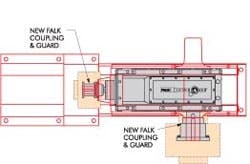Gear replacement is simple with a good plan
When a gear drive needs to be replaced, it can be frustrating when an exact replacement isn’t available. A user might have no choice but to search used equipment lists or buy a new and different drive. When the substitute equipment arrives, it might not fit properly or be as suited for the intended use as the original drive. When replacing a gear drive, consider:
How does the replacement fit the envelope of the existing drive? The most obvious concern is the base-to-centerline distance. It might not be an issue, because drives have gotten smaller in each generation, but it can be a deal-breaker if the drive being replaced is of a newer generation. Other important dimensional concerns include space considerations and interference with connected equipment or structures. Also consider what must be done with the motor to accommodate the new drive.
How does the replacement fit the connected/connecting equipment? Changes in solid-shaft diameters will affect couplings, sheaves, sprockets and other mounted equipment. Changes in bores of hollow-shaft-mounted drives might make installation difficult or impossible.
Are there any foreseeable mechanical issues? When a drive is replaced, application parameters should be confirmed. Older drives were designed conservatively, so users could increase power over time without causing any problems. In some cases, motor horsepower and loads were increased by 50% to 100%, and newer drives of the same rating, developed with less conservative designs, will not last long.
[pullquote]
It is unlikely a new drive will have exactly the same gear ratio as the drive it replaces. In most applications, “close” is good enough, but in some cases, a change in ratio will be detrimental. These might include certain pump applications, dual drives and metering conveyors, among others. In these cases, request a special ratio that is the same or near that of the old drive.
Relative shaft rotations also might be an issue. Replacing a double-reduction gearbox with a triple-reduction gearbox might cause insurmountable problems if the driver is an engine with a fixed direction of rotation. On electric motors, the leads can be switched to change the direction of motor shaft rotation. Other elements in the drive train might have to rotate in a specific direction, such as some variable-fill fluid couplings and clutches.
To obtain the best-matched, easiest-to-install drive:
- Work with a supplier you know has the experience and attention to detail to handle the undertaking. This is not a job to shop around to the lowest bidder.
- Your gear drive manufacturer should have a good library of competitive drive information. Knowing critical dimensional and rating information of the drive to be replaced is extremely important, and the competitive knowledge can help offset a lack of detailed user records.
- Give the bidder all the information about the application. Original paperwork and drawings are a plus, but certainly get full information from the existing drive nameplate, then verify that it reflects current operation. Make sure the bidder includes a site visit to see the application.
- Ask for a written proposal and insist that it include full information on what will be required in the interchange. Will it require moving the motor; ordering a new coupling, sheave or sprocket; re-drilling the foundation or other changes?
- Finally, make every attempt to simplify the change-out. Ask the bidder to provide a “drop-in” with an adapter base or bedplate to suit the existing foundation, new coupling hub, etc.
In one case, a world-class producer of industrial chemicals needed to replace the gear drive on an agitator vessel at one of its North American plants. A replacement wasn’t available from the original manufacturer, and a custom gearbox built to fit the application would have required a 25-week lead time. Instead, the company’s contract engineering firm worked with Rexnord Industries LLC (www.rexnord.com), which made a transition base that allowed a drop-in replacement with a standard Falk gear drive in less than four weeks.
The new, smaller Falk gear drive was adapted to replace the old, larger agitator gear drive with a custom transition base, new couplings and guards.
Because the company was rebuilding the equipment, time was less of an issue than in a breakdown situation. However, the long lead time and considerably higher cost of a custom gearbox made the alternative of a standard gearbox with a custom base a better choice.
The solution included a Falk M1150DBC3 reducer with a 64.67:1 ratio, a transition base, AirMax breather kit, sealed dipstick to exclude moisture, Wrapflex 20R10 high-speed coupling, Steelflex 1130T10 low-speed coupling, and coupling guard.
The project manager says the company has similar equipment at other plants, some of which has been running for 45 years. He notes that the combination of the standard gear drive and adapter base provides a standard design that will make it easier to replace these drives when necessary. In fact, the company already has ordered two more of the drive packages for similar equipment at one of its plants in France.
Nick Derus, applications engineer/product interchange specialist, and Rick Lynch, marketing manager, work for Rexnord Industries LLC, Milwaukee. Call them at (414) 937-4223 or e-mail [email protected].

